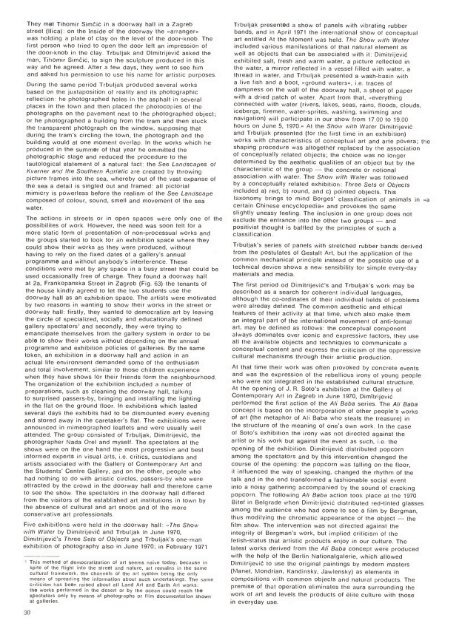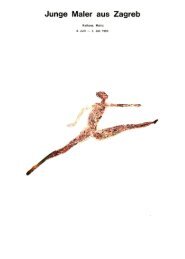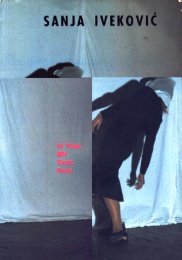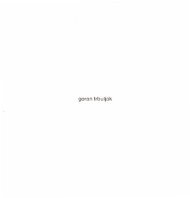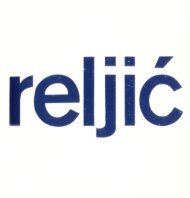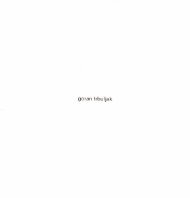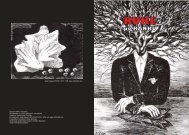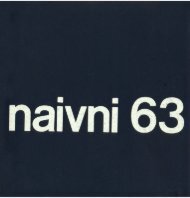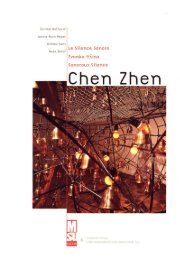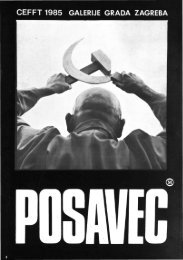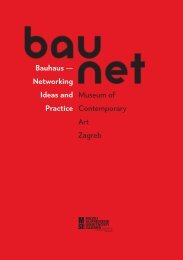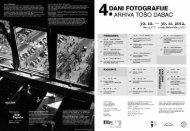The New Art Practice in Yugoslavia, 1966-1978
The New Art Practice in Yugoslavia, 1966-1978
The New Art Practice in Yugoslavia, 1966-1978
- TAGS
- practice
- yugoslavia
- www.msu.hr
Create successful ePaper yourself
Turn your PDF publications into a flip-book with our unique Google optimized e-Paper software.
<strong>The</strong>y met Tihomir Simi <strong>in</strong> a doorway hall <strong>in</strong> a Zagreb<br />
street (llica): on the <strong>in</strong>side of the doorway the «arranger"<br />
was hold<strong>in</strong>g a plate of clay on the level of the door-knob. <strong>The</strong><br />
first person who tried to open the door left an impression of<br />
the door-knob <strong>in</strong> the clay. Trbuljak and Dimitrijevi asked the<br />
man, Tihomir Simi, to sign the sculpture produced <strong>in</strong> this<br />
way and he agreed. After a few days, they went to see him<br />
and asked his permission to use his name for artistic purposes.<br />
Dur<strong>in</strong>g the same period Trbuljak produced several works<br />
based on the juxtaposition of reality and its photographic<br />
reflection: he photographed holes <strong>in</strong> the asphalt <strong>in</strong> several<br />
places <strong>in</strong> the town and then placed the photocopies of the<br />
photographs on the pavement next to the photographed object;<br />
or he photographed a build<strong>in</strong>g from the tram and then stuck<br />
the transparent photograph on the w<strong>in</strong>dow, suppos<strong>in</strong>g that<br />
dur<strong>in</strong>g the tram's circl<strong>in</strong>g the town, the photograph and the<br />
build<strong>in</strong>g would at one moment overlap. In the works which he<br />
produced <strong>in</strong> the summer of that year he ommitted the<br />
photographic stage and reduced the procedure to the<br />
tautological statement of a natural fact: the See Landscapes of<br />
Kvarner and the Southern Adriatic are created by throw<strong>in</strong>g<br />
picture frames <strong>in</strong>to the sea, whereby out of the vast expanse of<br />
the sea a detail is s<strong>in</strong>gled out and framed: all pictorial<br />
mimicry is powerless before the realism of the See Landscape<br />
composed of colour, sound. smell and movement of the sea<br />
water.<br />
<strong>The</strong> actions <strong>in</strong> streets or <strong>in</strong> open spaces were only one of the<br />
possibilites of work. However, the need was soon felt for a<br />
more static form of presentation of non-processual works and<br />
the groups started to look for an exhibition space where they<br />
could show their works as they were produced, without<br />
hav<strong>in</strong>g to rely on the fixed dates of a gallery's annual<br />
programme and without anybody's <strong>in</strong>terference. <strong>The</strong>se<br />
conditions were met by any space <strong>in</strong> a busy street that could be<br />
used occasionally free of charge. <strong>The</strong>y found a doorway hall<br />
at 2a, Frankopanska Street <strong>in</strong> Zagreb (Fig. 63) the tenants of<br />
the house k<strong>in</strong>dly agreed to let the two students use the<br />
doorway hall as an exhibition space. <strong>The</strong> artists were motivated<br />
by two reasons <strong>in</strong> want<strong>in</strong>g to show their works <strong>in</strong> the street or<br />
doorway hall: firstly, they wanted to democratize art by leav<strong>in</strong>g<br />
the circle of specialized, socially and educationally def<strong>in</strong>ed<br />
gallery spectators and secondly, they were try<strong>in</strong>g to<br />
emancipate themselves from the gallery system <strong>in</strong> order to be<br />
able to show their works without depend<strong>in</strong>g on the annual<br />
programme and exhibition policies of galleries. By the same<br />
token, an exhibition <strong>in</strong> a doorway hall and action <strong>in</strong> an<br />
actual life environment demanded some of the enthusiasm<br />
and total <strong>in</strong>volvement, similar to those children experience<br />
when they have shows for their friends form the neighbourhood.<br />
<strong>The</strong> organization of the exhibition <strong>in</strong>cluded a number of<br />
preparations, such as clean<strong>in</strong>g the doorway hall, talk<strong>in</strong>g<br />
to surprised passers-by, br<strong>in</strong>g<strong>in</strong>g and <strong>in</strong>stall<strong>in</strong>g the light<strong>in</strong>g<br />
<strong>in</strong> the flat on the ground floor. In exhibitions which lasted<br />
several days the exhibits had to be dismounted every even<strong>in</strong>g<br />
and stored away <strong>in</strong> the caretaker's flat. <strong>The</strong> exhibitions were<br />
announced <strong>in</strong> mimeographed leaflets and were usually well<br />
attended <strong>The</strong> group consisted of Trbuljak, Dimitrijevi, the<br />
photographer Nada Orel and myself. <strong>The</strong> spectators at the<br />
shows were on the one hand the most progressive and best<br />
<strong>in</strong>formed experts <strong>in</strong> visual arts, i.e. critics, custodians and<br />
artists associated with the Gallery of Contemporary <strong>Art</strong> and<br />
the Students' Centre Gallery, and on the other, people who<br />
had noth<strong>in</strong>g to do with artistic circles, passers-by who were<br />
attracted by the crowd <strong>in</strong> the doorway hall and therefore came<br />
to see the show. <strong>The</strong> spectators <strong>in</strong> the doorway hall differed<br />
from the visitors of the established art <strong>in</strong>stitutions <strong>in</strong> town by<br />
the absence of cultural and art snobs and of the more<br />
conservative art professionals.<br />
Five exhibitions were held <strong>in</strong> the doorway hall: «<strong>The</strong> Show<br />
with Water by Dimitrijevi and Trbuljak <strong>in</strong> June 1970,<br />
DimitrijeviCs Three Sets of Objects and Trbuljak's one-man<br />
exhibition of photography also <strong>in</strong> June 1970; <strong>in</strong> February 1971<br />
30<br />
This method of democratization of art seems naive today, because <strong>in</strong><br />
spite of the flight <strong>in</strong>to the street and nature, art rema<strong>in</strong>s <strong>in</strong> the same<br />
cultural framework. the channels of the art system be<strong>in</strong>g the only<br />
means of spread<strong>in</strong>g the <strong>in</strong>formation about such undertak<strong>in</strong>gs. <strong>The</strong> same<br />
criticism has been raised about all Land <strong>Art</strong> and Earth <strong>Art</strong> works,<br />
the works performed <strong>in</strong> the desert or by the ocean could reach the<br />
spectators only by means at photographs or film documentation shown<br />
at galleries,<br />
Trbuljak presented a show of panels with vibrat<strong>in</strong>g rubber<br />
bands, and <strong>in</strong> April 1971 the <strong>in</strong>ternational show of conceptual<br />
art entitled At the Moment was held. <strong>The</strong> Show with Water<br />
<strong>in</strong>cluded various manifestations of that natural element as<br />
well as objects that can be associated with it: Dimitrijevi<br />
exhibited salt, fresh and warm water, a picture reflected <strong>in</strong><br />
the water, a mirror reflected <strong>in</strong> a vessel filled with water, a<br />
thread <strong>in</strong> water, and Trbuljak presented a wash-bas<strong>in</strong> with<br />
a live fish and a boot, «ground waters", i.e. traces of<br />
dampness on the wall of the doorway hall, a sheet of paper<br />
with a dried patch of water. Apart from that, «everyth<strong>in</strong>g<br />
connected with water (rivers. lakes, seas, ra<strong>in</strong>s, floods, clouds,<br />
icebergs, firemen, water-sprites. wash<strong>in</strong>g, swimm<strong>in</strong>g and<br />
navigation) will participate <strong>in</strong> our show from 17.00 to 19.00<br />
hours on June 5, 1970." At the Show with Water Dimitrijevi<br />
and Trbuljak presented (for the first time <strong>in</strong> an exhibition)<br />
works with characteristics of conceptual art and arte povera: the<br />
shap<strong>in</strong>g procedure was altogether replaced by the association<br />
of conceptually related objects: the choice was no longer<br />
determ<strong>in</strong>ed by the aesthetic qualities of an object but by the<br />
characteristic of the group the concrete or notional<br />
association with water. <strong>The</strong> Show with Water was followed<br />
by a conceptually related exhibition: Three Sets of Objects<br />
<strong>in</strong>cluded a) red, b) round, and c) po<strong>in</strong>ted objects. This<br />
taxonomy br<strong>in</strong>gs to m<strong>in</strong>d Borges' classification of animals <strong>in</strong> «a<br />
certa<strong>in</strong> Ch<strong>in</strong>ese encyclopedia" and provokes the same<br />
slightly uneasy feel<strong>in</strong>g. <strong>The</strong> <strong>in</strong>clusion <strong>in</strong> one group does not<br />
exclude the entrance <strong>in</strong>to the other two groups and<br />
positivist thought is baffled by the pr<strong>in</strong>ciples of such a<br />
classification.<br />
Trbuljak's series of panels with stretched rubber bands derived<br />
from the postulates of Gestalt <strong>Art</strong>, but the application of the<br />
common mechanical pr<strong>in</strong>ciple <strong>in</strong>stead of the possible use of a<br />
technical device shows a new sensibility for simple every-day<br />
materials and media.<br />
<strong>The</strong> first period od Dimitrijevi's and Trbuljak's work may be<br />
described as a search for coherent <strong>in</strong>dividual languages,<br />
although the co-ord<strong>in</strong>ates of their <strong>in</strong>dividual fields of problems<br />
were alreday def<strong>in</strong>ed. <strong>The</strong> common aesthetic and ethical<br />
features of their activity at that time, which also make them<br />
an <strong>in</strong>tegral part of the <strong>in</strong>ternational movement of anti-formal<br />
art, may be def<strong>in</strong>ed as follows: the conceptual component<br />
always dom<strong>in</strong>ates over iconic and expressive factors, they use<br />
all the available objects and techniques to communicate a<br />
conceptual content and express the criticism of the oppressive<br />
cultural mechanisms through their artistic production.<br />
At that time their work was often provoked by concrete events<br />
and was the expression of the rebellious irony of young people<br />
who were not <strong>in</strong>tegrated <strong>in</strong> the established cultural structure.<br />
At the open<strong>in</strong>g of J. R. Soto's exhibition at the Gallery of<br />
Contemporary <strong>Art</strong> <strong>in</strong> Zagreb <strong>in</strong> June 1970, Dimitrijevi<br />
performed the first action of the Ali Baba series. <strong>The</strong> Ali Baba<br />
concept is based on the <strong>in</strong>corporation of other people's works<br />
of art (the metaphor of Ali Baba who steals the treasure) <strong>in</strong><br />
the structure of the mean<strong>in</strong>g of one's own work. In the case<br />
of Soto's exhibition the irony was not directed aga<strong>in</strong>st the<br />
artist or his work but aga<strong>in</strong>st the event as such, i.e. the<br />
open<strong>in</strong>g of the exhibition. Dimitrijevi distributed popcorn<br />
among the spectators and by this <strong>in</strong>tervention changed the<br />
course of the open<strong>in</strong>g: the popcorn was fall<strong>in</strong>g on the floor,<br />
it <strong>in</strong>fluenced the way of speak<strong>in</strong>g, changed the rhythm of the<br />
talk and <strong>in</strong> the end transformed a fashionable social event<br />
<strong>in</strong>to a noisy gather<strong>in</strong>g accompanied by the sound of crack<strong>in</strong>g<br />
popcorn. <strong>The</strong> follow<strong>in</strong>g Ali Baba action took place at the 1970<br />
Bitef <strong>in</strong> Belgrade when Dimitrijevi distributed red-t<strong>in</strong>ted glasses<br />
among the audience who had come to see a film by Bergman,<br />
thus modify<strong>in</strong>g the chromatic appearance of the object the<br />
film show. <strong>The</strong> <strong>in</strong>tervention was not directed aga<strong>in</strong>st the<br />
<strong>in</strong>tegrity of Bergman's work, but implied criticism of the<br />
fetish-status that artistic products enjoy <strong>in</strong> our culture. <strong>The</strong><br />
latest works derived from the Ali Baba concept were produced<br />
with the help of the Berl<strong>in</strong> Nationalgalerie, which allowed<br />
Dimitrijevi to use the orig<strong>in</strong>al pa<strong>in</strong>t<strong>in</strong>gs by modern masters<br />
(Manet, Mondrian, Kand<strong>in</strong>sky, Jawlensky) as elements <strong>in</strong><br />
compositions with common objects and natural products. <strong>The</strong><br />
premise of that operation elim<strong>in</strong>ates the aura surround<strong>in</strong>g the<br />
work of art and levels the products of élite culture with those<br />
<strong>in</strong> everyday use.


